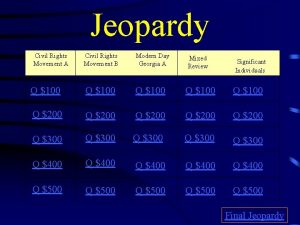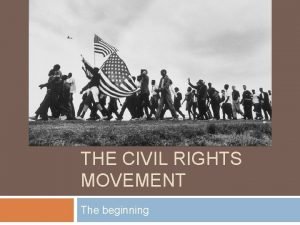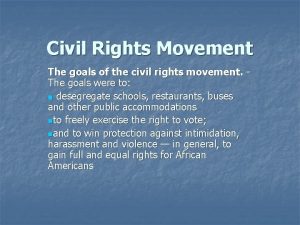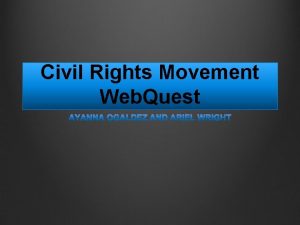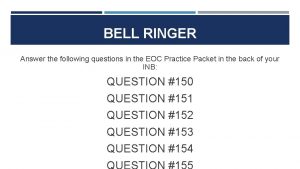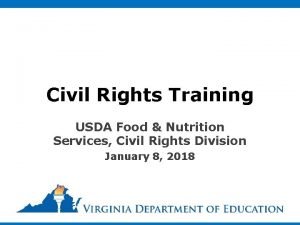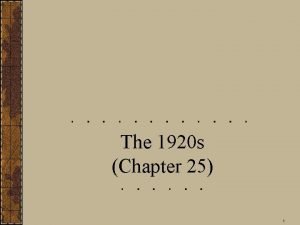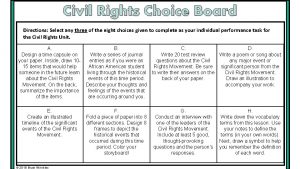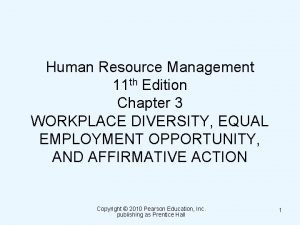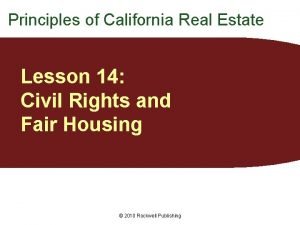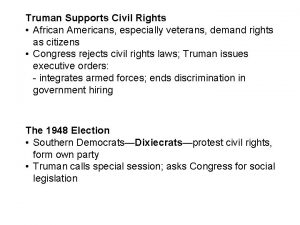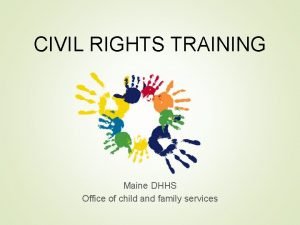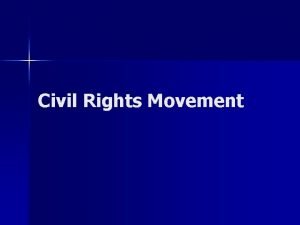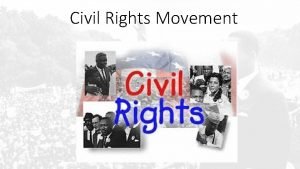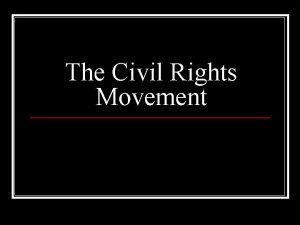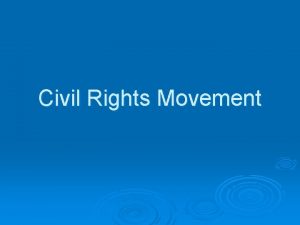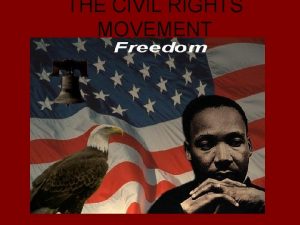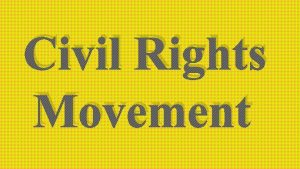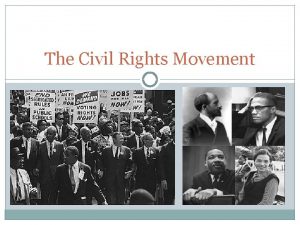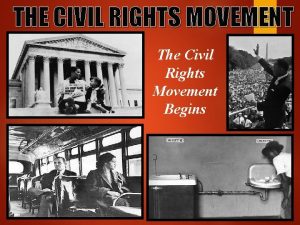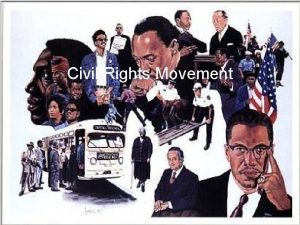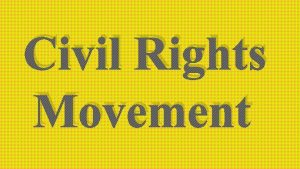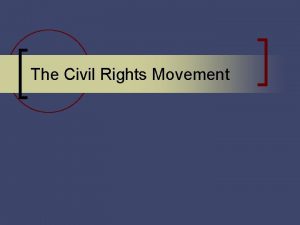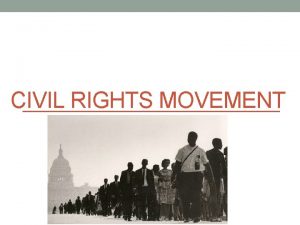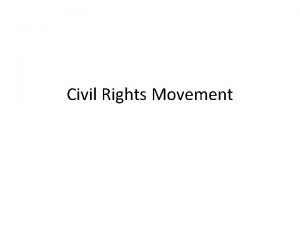The Civil Rights Movement 27 1 Early Demands


















- Slides: 18

The Civil Rights Movement 27. 1 Early Demands for Equality

Segregation Divides America • Dissatisfied with second class status

Jim Crow Laws Limit African Americans • Segregation that is imposed by law is known as de jure segregation. • Plessy vs. Fergusen, the Supreme Court had ruled that such segregation was constitutional as log as the facilities for blacks and whites were “separate but equal”. (rarely the case)

Segregation Prevails Around the Nation • De facto segregation or segregation by unwritten customs or tradition, was a fact of life. • Racial segregation, especially in public schools, that happens “by fact” rather than by legal requirement. For example, often the concentration of African-Americans in certain neighborhoods produces neighborhood schools that are predominantly black, or segregated in fact ( de facto ), although not by law ( de jure ). • de facto segregation occurs when widespread individual preferences, sometimes backed up with private pressure, lead to separation.

The Civil Rights Movement Grows • WWII set the stage for rise of the modern civil rights movement. • Roosevelt banning discrimination in defense industries • Gunner Myrdals publication in 1944 of an American Dilemma • A. A. Unwilling to accept discrimination at home. • CORE (Congress of Racial Equality) • Influenced by Henry David Thoreau and Mohandas Gandhi, • Believed A. A. could get civil rights non violently. • Jackie Robinson joined the Brooklyn Dodgers becoming the first A. A. to play major league baseball.

• Radical violence in South • Committee on Civil Rights to investigate race relations. • Ensure equal opportunity for all • Truman was unable to win support for these • Truman did desegregate military.

Brown V. S. Board of Education: NAACP Challenges Segregation • End of WWII NAACP was largest and most powerful civil rights organization in the nation. • Thurgood Marshall an African American lawyer from • Baltimore headed the legal team that mounted this challenge. • 1950 the NAACP won a number of key cases. • Sweat v. Painter, the Supreme Court ruled that the state of Texas had violated the 14 th Amendment by establishing a separate but unequal all black law school. • Mc. Laurin v. Oklahoma State Regents, the Court ruled that the state of Oklahoma had violated George Mc. Laurin’s constitutional rights. • According to the Supreme Court, a truly equal education involved more than simply admitting African Americans to previously all white universities.

The Court Strikes Down Segregated Schools • In Brown case the NAACP challenged the separate but equal principle itself which had been established in the 1896 Plessy v. Ferguson case. • In Topeka, Kansas in the 1950 s, schools were segregated by race. Each day, Linda Brown and her sister had to walk through a dangerous railroad switchyard to get to the bus stop for the ride to their all-black elementary school. • There was a school closer to the Brown's house, but it was only for white students. Linda Brown and her family believed that the segregated school system violated the Fourteenth Amendment and took their case to court. • Federal district court decided that segregation in public education was harmful to black children, but because all-black schools and all-white schools had similar buildings, transportation, curricula, and teachers, the segregation was legal.

• The Browns appealed their case to Supreme Court stating that even if the facilities were similar, segregated schools could never be equal to one another. • The Court decided that state laws requiring separate but equal schools violated the Equal Protection Clause of the Fourteenth Amendment.

Reaction to Brown • Most significant and controversial in American History. • In Brown II the court called for implementation of its decision with all deliberate speed across the nation. • The Southern Manifesto: pledged to oppose the Brown ruling through all lawful means on the grounds that the court had misinterpreted the Constitution.

Federal and State Governments Clash: A Conflict Erupts in Little Rock • Little Rock school board had established a plan to gradually desegregate its schools beginning with Central High School. • While some school districts began developing strategies to resist public school desegregation, school officials at Little Rock, Arkansas stated that they would comply with the Supreme Court's ruling. • School district officials created a system in which black students interested in attending white only schools were put through a series of rigorous interviews to determine whether they were suited for admission. • School officials interviewed approximately eighty black students for Central High School, the largest school in the city. Only nine were chosen, Melba Patillo Beals, Elizabeth Eckford, Ernest Green, Gloria Ray Karlmark, Carlotta Walls Lanier, Terrance Roberts, Jefferson Thomas, Minnijean Brown Trickey, and Thelma Mothershed Wair. • They would later become known around the world as the “Little Rock Nine. ” Little Rock civil rights activist Daisy Lee Bates would serve as their spokesperson and organizer.

• Although skeptical about integrating a former white-only institution, the nine students arrived at Central High School on September 3, 1957 looking forward to a successful academic year. • Instead they were greeted by an angry mob of white students, parents, and citizens determined to stop integration. • In addition to facing physical threats, screams, and racial slurs from the crowd, Arkansas Governor Orval M. Faubus intervened, ordering the Arkansas National Guard to keep the nine African American students from entering the school. • Faced with no other choice, the “Little Rock Nine” gave up their attempt to attend Central High School which soon became the center of a national debate about civil rights, racial discrimination and States’s rights.

• On September 20, 1957, Federal Judge Ronald Davies ordered Governor Faubus to remove the National Guard from the Central High School’s entrance and to allow integration to take its course in Little Rock. • When Faubus defied the court order, President Dwight Eisenhower dispatched nearly 1, 000 paratroopers and federalized the 10, 000 Arkansas National Guard troops who were to ensure that the school would be open to the nine students. • On September 23, 1957, the “Little Rock Nine” returned to Central High School where they were enrolled. Units of the United States Army remained at the school for the rest of the academic year to guarantee their safety.

Congress Passes a Civil Rights Law • primarily a voting rights bill, was the first federal civil rights legislation passed by the United States Congress since the Civil Rights Act of 1875. The purpose of the Civil Rights Act of 1957 was to show the federal government's support for racial equality following the Supreme Court's 1954 Brown decision. • Created the United States Civil Commission which had the power to investigate violations of civil rights.

Montgomery Bus Boycott • Rosa Parks, an African American seamstress, boarded a bus in Montgomery, Alabama, and sat down in an empty seat. • Rosa Parks, an African-American woman, refused to yield her seat to a white man on a Montgomery bus. She was arrested and fined. The boycott of public buses by blacks in Montgomery began on the day of Parks’ court hearing and lasted 381 days.

Rosa Parks Launches a Movement • Chain of events that launched a civil rights movement. • The boycott of public buses by blacks in Montgomery began on the day of Parks’ court hearing and lasted 381 days. • The U. S. Supreme Court ultimately ordered Montgomery to integrate its bus system, and one of the leaders of the boycott, a young pastor named Martin Luther King Jr. (1929 -68), emerged as a prominent national leader of the American civil rights movement in the wake of the action.

Martin Luther King Urges Nonviolence • On the afternoon of December 5, black leaders met to form the Montgomery Improvement Association (MIA). The group elected Martin Luther King Jr. (1929 -68), the 26 -year-old-pastor of Montgomery’s Dexter Avenue Baptist Church, as its president, and decided to continue the boycott until the city met its demands. • Initially, the demands did not include changing the segregation laws; rather, the group demanded courtesy, the hiring of black drivers, and a first -come, first-seated policy, with whites entering and filling seats from the front and African Americans from the rear. Ultimately, however, a group of five Montgomery women, represented by attorney Fred D. Gray (1932 -) and the NAACP, sued the city in U. S. District Court, seeking to have the busing segregation laws invalidated.

Minister from SCLC • Shortly after the boycott’s end, he helped found the Southern Christian Leadership Conference (SCLC), a highly influential civil rights organization that worked to end segregation throughout the South. • The SCLC was influential in the civil rights campaign in Birmingham, Alabama, in the spring of 1963, and the March on Washington in August of that same year, during which King delivered his famous “I Have a Dream” speech. • The boycott also brought national and international attention to the civil rights struggles occurring in the U. S. , as more than 100 reporters visited Montgomery during the boycott to profile the effort and its leaders
 Civil rights webquest
Civil rights webquest Civil rights movement jeopardy
Civil rights movement jeopardy The civil rights movement
The civil rights movement Goals of the civil rights movement
Goals of the civil rights movement Civil rights movement essential questions
Civil rights movement essential questions Civil rights movement vocabulary
Civil rights movement vocabulary Mother of the modern day civil rights movement
Mother of the modern day civil rights movement Civil rights movement webquest
Civil rights movement webquest Civil rights bell ringers
Civil rights bell ringers Usda civil rights training
Usda civil rights training Chapter 14 postwar prosperity and civil rights
Chapter 14 postwar prosperity and civil rights Brain wrinkles answer key
Brain wrinkles answer key Civil rights choice board
Civil rights choice board Chapter 14 postwar prosperity and civil rights
Chapter 14 postwar prosperity and civil rights Title vii of the civil rights act
Title vii of the civil rights act Unruh civil rights act real estate
Unruh civil rights act real estate Truman supports civil rights
Truman supports civil rights Civil rights in child nutrition programs
Civil rights in child nutrition programs Civil rights training certificate
Civil rights training certificate

